Screening Approach of the Langley Calibration Station for Sun Photometers in China
Abstract
:1. Introduction
2. Related Work
2.1. Principle of the Langley Plot Method
2.2. Conditions for a Suitable Calibration Station
3. Data Processing and Analysis
3.1. The Condition of Latitude
3.2. The Condition of Atmospheric Stability
3.2.1. Satellite-Derived Data
3.2.2. Space Matching between Satellite-Derived Data and Ground Station
3.2.3. Atmospheric Stability Analysis of Ground Stations
3.3. Analyzing the Number of Clear-Sky Days
3.4. Boundary Layer Depth Analysis
4. Stations Analysis
5. Summary
Author Contributions
Funding
Data Availability Statement
Conflicts of Interest
References
- Bender, F.A.M.; Frey, L.; Mccoy, D.T.; Grosvenor, D.P.; Mohrmann, J. Assessment of aerosol-cloud-radiation correlations in satellite observations, climate models and reanalysis. Clim. Dynam. 2018, 52, 4371–4392. [Google Scholar] [CrossRef]
- Hua, S. Study on Aerosol-Cloud Interaction and Cloud Radiative Effect Over the Tibetan Plateau. Ph.D. Thesis, Lanzhou University, Lanzhou, China, 2020. [Google Scholar]
- López-Romero, J.M.; Montávez, J.P.; Jerez, S.; Lorente-Plazas, R.; Jiménez-Guerrero, P. Precipitation response to aerosol-radiation and aerosol-cloud interactions in regional climate simulations over Europe. Atmos. Chem. Phys. 2021, 21, 415–430. [Google Scholar] [CrossRef]
- Xie, X.H. Researches on Aerosol Optical Properties of Kunming Using CE318 Sunphotometer and MODIS Measurements. Master’s Thesis, Yunnan University, Kunming, China, 2015. [Google Scholar]
- Zhao, J.F.; Jiang, Y.Q.; Zhan, X.; Kong, X.N. Advances in Research of Impacts of Aerosol Pollution on Crop in China. Adv. Meteorol. Sci. Technol. 2018, 8, 6–10. [Google Scholar]
- Vladutescu, D.V.; Madhavan, B.L.; Gross, B.M.; Aguirre, A.; Moshary, F.; Ahmed, S.A.; Razani, M.; Blake, R.A. Assessment of Langley and NASA-GISS Calibration Techniques for MFRSR Aerosol Retrieval. IEEE Trans. Geosci. Remote Sens. 2014, 52, 5880–5894. [Google Scholar] [CrossRef]
- Alexandrov, M.D.; Lacis, A.A.; Carlson, B.E.; Cairns, B. Remote Sensing of Atmospheric Aerosols and Trace Gases by Means of Multifilter Rotating Shadowband Radiometer. Part I: Retrieval Algorithm. J. Atmos. Sci. 2002, 59, 524–543. [Google Scholar] [CrossRef]
- Wu, Y.F.; Zhu, J.; Che, H.Z.; Xia, X.G.; Zhang, R.J. Column-integrated aerosol optical properties and direct radiative forcing based on sun photometer measurements at a semiarid rural site in Northeast China. Atmos. Res. 2015, 157, 56–65. [Google Scholar] [CrossRef]
- Yan, H.; Jiao, M.Y.; Bi, B.G.; Liu, G.Q. Advances in Aerosol Observation Network and corresponding science plan. J. Meteorol. Sci. 2006, 26, 110–117. [Google Scholar] [CrossRef]
- Eck, T.F.; Holben, B.; Reid, J.; Dubovik, O.; Smirnov, A.; O’neill, N.; Slutsker, I.; Kinne, S. Wavelength dependence of the optical depth of biomass burning, urban, and desert dust aerosols. J. Geophys. Res. Atmos. 1999, 104, 31333–31349. [Google Scholar]
- Holben, B.N.; Eck, T.F.; Slutsker, I.a.; Tanré, D.; Buis, J.; Setzer, A.; Vermote, E.; Reagan, J.A.; Kaufman, Y.; Nakajima, T. AERONET—A federated instrument network and data archive for aerosol characterization. Remote Sens. Environ. 1998, 66, 1–16. [Google Scholar] [CrossRef]
- Brooks, D.R.; Mims, F.M. Development of an inexpensive handheld LED-based Sun photometer for the GLOBE program. J. Geophy. Res. Atmos. 2001, 106, 4733–4740. [Google Scholar] [CrossRef]
- Luo, J.; Yi, W.N.; He, C.L.; Peng, N.M. Implement of solar photometer calibration by transferring of radiometric radiator. J. Atmos. Environ. Opt. 2006, 1, 112–116. [Google Scholar] [CrossRef]
- Huang, D.; Li, X.; Zhang, Y.N.; Zhang, Q.; Zheng, X.B.; Sun, L. Field calibration of sunphotometer in Dunhuang test site. Acta Photonica Sin. 2019, 48, 142–151. [Google Scholar] [CrossRef]
- Shaw, G.E. Sun Photometry. Bull. Am. Meteorol. Soc. 1983, 64, 4–10. [Google Scholar] [CrossRef]
- Campanelli, M.; Nakajima, T.; Olivieri, B. Determination of the solar calibration constant for a sun-sky radiometer: Proposal of an in-situ procedure. Appl. Opt. 2004, 43, 651–659. [Google Scholar] [CrossRef]
- Wang, X.H.; Qiao, Y.L.; Philip, G.; Li, Z.Q. Sun radiometer calibration system for global aerosol measurement network. Acta Opt. Sin. 2008, 28, 87–91. [Google Scholar] [CrossRef]
- Che, H.Z.; Zhang, X.Y.; Chen, H.B.; Damiri, B.; Goloub, P.; Li, Z.Q.; Zhang, X.C.; Wei, Y.; Zhou, H.G.; Dong, F.; et al. Instrument calibration and aerosol optical depth validation of the China Aerosol Remote Sensing Network. J. Geophy. Res. Atmos. 2009, 114, D03206. [Google Scholar] [CrossRef]
- Liu, Z.Y. Analysis on the Characteristic of Aerosol Optical Depth Changed with Season in Delingha and Hefei. Master’s Thesis, University Science Technology China, Hefei, China, 2017. [Google Scholar]
- Qie, L.L.; Dai, C.M.; Xu, Q.S.; Wei, H.L. Calibration of near-infrared absorption band for a sun-photometer. Natl. Remote Sens. Bull. 2012, 16, 928–938. [Google Scholar] [CrossRef]
- Dong, Z.P.; Yu, X.; Lu, D.; Dai, J.; Li, X.M.; Chen, C.; Peng, Y.; Dong, Y. An objective method for assessment of Langley calibrations of sunphotometer. Chin. J. Atmos. Sci. 2020, 44, 39–52. [Google Scholar] [CrossRef]
- Holben, B.N.; Tanré, D.; Smirnov, A.; Eck, T.F.; Slutsker, I.; Abuhassan, N.; Newcomb, W.W.; Schafer, J.S.; Chatenet, B.; Lavenu, F.; et al. An emerging ground-based aerosol climatology: Aerosol optical depth from AERONET. J. Geophy. Res. Atmos. 2001, 106, 12067–12097. [Google Scholar] [CrossRef]
- Li, Z.Q.; Li, D.H.; Li, K.Y.; Xu, H.; Chen, X.F.; Chen, C.; Xie, Y.S.; Li, L.; Li, L.; Lv, Y.; et al. Sun-sky radiometer observation network with the extension of multi-wavelength polarization measurements. J. Remote Sens. 2015, 19, 495–519. [Google Scholar] [CrossRef]
- Swinehart, D.F. The beer-lambert law. J. Chem. Educ. 1962, 39, 333. [Google Scholar] [CrossRef]
- Kasten, F.; Young, A.T. Revised optical air mass tables and approximation formula. Appl. Opt. 1989, 28, 4735–4738. [Google Scholar] [CrossRef] [PubMed]
- Shaw, G.E.; Reagan, J.A.; Herman, B.M. Investigations of atmospheric extinction using direct solar radiation measurements made with a multiple wavelength radiometer. J. Appl. Meteorol. Clim. 1973, 12, 374–380. [Google Scholar] [CrossRef]
- Xin, J.Y.; Wang, Y.S.; Li, Z.Q.; Wang, P.C.; Wang, S.G.; Wen, T.X.; Sun, Y. Introduction and calibration of the Chinese sun hazemeter network. Environ. Sci. 2006, 27, 1697–1702. [Google Scholar] [CrossRef]
- Zhang, J.H.; Wang, M.H.; Mao, J.T. Error analysis and correction for multi-wavelength sun-photometer aerosol remote sensing. Chin. J. Atmos. Sci. 2000, 24, 855–859. [Google Scholar] [CrossRef]
- Carlund, T.; Kouremeti, N.; Kazadzis, S.; Grobner, J. Aerosol optical depth determination in the UV using a four-channel precision filter radiometer. Atmos. Meas. Tech. 2017, 10, 905–923. [Google Scholar] [CrossRef]
- Jeong, U.; Tsay, S.C.; Pantina, P.; Butler, J.J.; Loftus, A.M.; Abuhassan, N.; Herman, J.R.; Dimov, A.; Holben, B.N.; Swap, R.J. Langley Calibration Analysis of Solar Spectroradiometric Measurements: Spectral Aerosol Optical Thickness Retrievals. J. Geophy. Res. Atmos. 2018, 123, 4221–4238. [Google Scholar] [CrossRef]
- Weihs, P.; Dirmhirn, I.; Czerwenka-Wenkstetten, I.M. Calibration of sunphotometer for measurements of turbidity. Theor. Appl. Climatol. 1995, 51, 97–104. [Google Scholar] [CrossRef]
- Li, X. Assessment of calibration results of sun photometers with conventional meteorological data. Meteorol. Sci. Technol. 2009, 37, 79–84. [Google Scholar] [CrossRef]
- Liu, J.J.; Wang, G.Y.; Xu, Z.X.; Liu, Y.; Wang, J.; Yan, Q.; Hua, D.X. Study on calibration method of sky radiometer and aerosol optical properties in Xi’an region. Infrared Laser Eng. 2020, 49, 257–263. [Google Scholar] [CrossRef]
- Tong, J.L.; Zhao, Y.R.; Zhao, Z.Y.; Zhang, W.Y. Research on calibration method of sunphotometer in semi-arid areas. Acta Opt. Sin. 2014, 34, 9–13. [Google Scholar] [CrossRef]
- Lee, K.H.; Li, Z.Q.; Cribb, M.C.; Liu, J.J.; Wang, L.; Zheng, Y.F.; Xia, X.G.; Chen, H.B.; Li, B. Aerosol optical depth measurements in eastern China and a new calibration method. J. Geophy. Res. Atmos. 2010, 115, D00K11. [Google Scholar] [CrossRef]
- Yang, Z.F. The Aerosol Optical Characteristics in Representative Regions Over China. Master’s Thesis, Chinese Academy of Meteorological Sciences, Beijing, China, 2008. [Google Scholar]
- Cerqueira, J.G.; Fernandez, J.H.; Hoelzemann, J.J.; Leme, N.M.P.; Sousa, C.T. Langley method applied in study of aerosol optical depth in the Brazilian semiarid region using 500, 670 and 870 nm bands for sun photometer calibration. Adv. Space Res. 2014, 54, 1530–1543. [Google Scholar] [CrossRef]
- Uchiyama, A.; Matsunaga, T.; Yamazaki, A. The instrument constant of sky radiometers (POM-02)—Part 1: Calibration constant. Atmos. Meas. Tech. 2018, 11, 5363–5388. [Google Scholar] [CrossRef]
- García, R.D.; García, O.E.; Cuevas, E.; Cachorro, V.E.; Barreto, A.; Guirado-Fuentes, C.; Kouremeti, N.; Bustos, J.J.; Romero-Campos, P.M.; Frutos, A.M. Aerosol optical depth retrievals at the Izaña atmospheric observatory from 1941 to 2013 by using artificial neural networks. Atmos. Meas. Tech. 2016, 9, 53–62. [Google Scholar] [CrossRef]
- Toledano, C.; Gonzalez, R.; Fuertes, D.; Cuevas, E.; Eck, T.F.; Kazadzis, S.; Kouremeti, N.; Grobner, J.; Goloub, P.; Blarel, L.; et al. Assessment of sun photometer Langley calibration at the high-elevation sites Mauna Loa and Izaña. Atmos. Chem. Phys. 2014, 18, 14555–14567. [Google Scholar] [CrossRef]
- Sayer, A.M.; Hsu, N.C.; Lee, J.; Bettenhausen, C.; Kim, W.V.; Smirnov, A.J.J.O.G.R.A. Satellite Ocean Aerosol Retrieval (SOAR) Algorithm Extension to S-NPP VIIRS as Part of the “Deep Blue” Aerosol Project. Available online: https://ladsweb.modaps.eosdis.nasa.gov/missions-and-measurements/products/AERDB_M3_VIIRS_SNPP (accessed on 13 March 2021).
- Doelling, D.R.; Sun, M.; Nguyen, L.T.; Nordeen, M.L.; Haney, C.O.; Keyes, D.F.; Mlynczak, P.E. Advances in Geostationary-Derived Longwave Fluxes for the CERES Synoptic (SYN1deg) Product. J. Atmos. Ocean. Tech. 2016, 33, 503–521. [Google Scholar] [CrossRef]
- Ignatov, A.; Minnis, P.; Loeb, N.; Wielicki, B.; Miller, W.; Sun-Mack, S.; Tanre, D.; Remer, L.; Laszlo, I.; Geier, E. Two MODIS aerosol products over ocean on the Terra and Aqua CERES SSF datasets. J. Atmos. Sci. 2005, 62, 1008–1031. [Google Scholar] [CrossRef]
- Biswas, J.; Pathak, B.; Patadia, F.; Bhuyan, P.K.; Gogoi, M.M.; Babu, S.S. Satellite-retrieved direct radiative forcing of aerosols over north-east India and adjoining areas: Climatology and impact assessment. Int. J. Climatol. 2017, 37, 298–317. [Google Scholar] [CrossRef]
- GMAO. MERRA-2 instM_2d_gas_Nx: 2d, Monthly mean, Instantaneous, Single-Level, Assimilation, Aerosol Optical Depth Analysis V5.12.4. Available online: https://disc.gsfc.nasa.gov/datasets/M2IMNXGAS_5.12.4/summary (accessed on 18 March 2021).
- Pang, S.T. Optical Characteristics of Aerosol in China Based on MERRA-2 Reanalysis and AERONET Ground-Based Remote Sensing. Master’s Thesis, Lanzhou University, Lanzhou, China, 2020. [Google Scholar]
- Zhang, Y. Variation of Total Ozone Over China for 30 Years and Meteorological Factors on Ozone Concentrations Near the Ground. Master’s Thesis, Nanjing University Information Science & Technology, Nanjing, China, 2014. [Google Scholar]
- Cuevas, E.; Milford, C.; Bustos, J.J.; del Campo-Hernández, R.; García, O.E.; García, R.D.; Gómez-Peláez, A.J.; Guirado-Fuentes, C.; Marrero, C.; Prats, N.; et al. Izaña Atmospheric Research Center Activity Report 2015–2016; State Meteorological Agency (AEMET): Madrid, Spain; World Meteorological Organization: Geneva, Switzerland, 2017. [Google Scholar]
- Yang, Z.F.; Zhang, X.Y.; Che, H.Z.; Zhang, X.C.; Hu, X.Q.; Zhang, L.J. An introductory study on the calibration of CE318 sunphotometer. J. Appl. Meteorol. Sci. 2008, 19, 297–306. [Google Scholar] [CrossRef]
- Liu, J.; Wang, X.J. Assessment on main kinds of satellite cloud climate datasets. J. Appl. Meteorol. Sci. 2017, 28, 654–665. [Google Scholar] [CrossRef]
- Karlsson, K.G.; Anttila, K.; Trentmann, J.; Stengel, M.; Solodovnik, I.; Meirink, J.F.; Devasthale, A.; Kothe, S.; Jääskeläinen, E.; Sedlar, J.; et al. CLARA-A2.1: CM SAF Cloud, Albedo and Surface Radiation Dataset from AVHRR data—Edition 2.1. Available online: https://wui.cmsaf.eu/safira/action/viewDoiDetails?acronym=CLARA_AVHRR_V002_01 (accessed on 18 March 2021).
- Chi, A.; Peter, K.; Matthew, L.; Joao, T. GPS Radio Occultation Boundary Layer Depth Annual L3 V1. Available online: https://disc.gsfc.nasa.gov/datasets/GPSROZPBLA_1/summary (accessed on 20 March 2021).
- Liu, L.Y.; Yao, Y.Q.; Yin, J.; Wang, H.S.; Li, J.R.; Zhou, Y.H.; You, X.L.; Tang, P.; Zhao, X.Y.; Ma, D.Q.; et al. Site testing campaign for the Large Optical Telescope at the Ali site. Res. Astron. Astrophys. 2020, 20, 63–72. [Google Scholar] [CrossRef]
- Qian, X.; Yao, Y.; Wang, H.; Wang, Y.; Bai, Z.; Yin, J. The Characteristics at the Ali Observatory Based on Radiosonde Observations. Publ. Astron. Soc. Pac. 2018, 130, 125002. [Google Scholar] [CrossRef]
- Liu, L.; Yao, Y.; Vernin, J.; Chadid, M.; Wang, Y.; Wang, H.; Yin, J.; Giordano, C.; Qian, X. Atmospheric turbulence measurements at Ali Observatory, Tibet. In Ground-Based and Airborne Telescopes IV; SPIE: Bellingham, WA, USA, 2012; Volume 8444. [Google Scholar]
- Qian, X.; Yao, Y.; Zou, L.; Wang, H.; Li, J. Optical turbulence in the atmospheric surface layer at the Ali Observatory, Tibet. Mon. Not. R. Astron. Soc. 2022, 510, 5179–5186. [Google Scholar] [CrossRef]
- Qian, X.; Yao, Y.; Wang, H.; Liu, L.; Li, J.; Yin, J. Numberical calculations of atmospheric conditions over Tibetan Plateau by using WRF Model. J. Phys. Conf. Ser. 2015, 595, 012028. [Google Scholar] [CrossRef]
- Wang, H.S.; Yao, Y.Q.; Liu, L.Y. Forecast of atmosphere optical turbulence at Ali site by weather research and forecasting model. Acta Photonica Sin. 2013, 33, 39–43. [Google Scholar] [CrossRef]

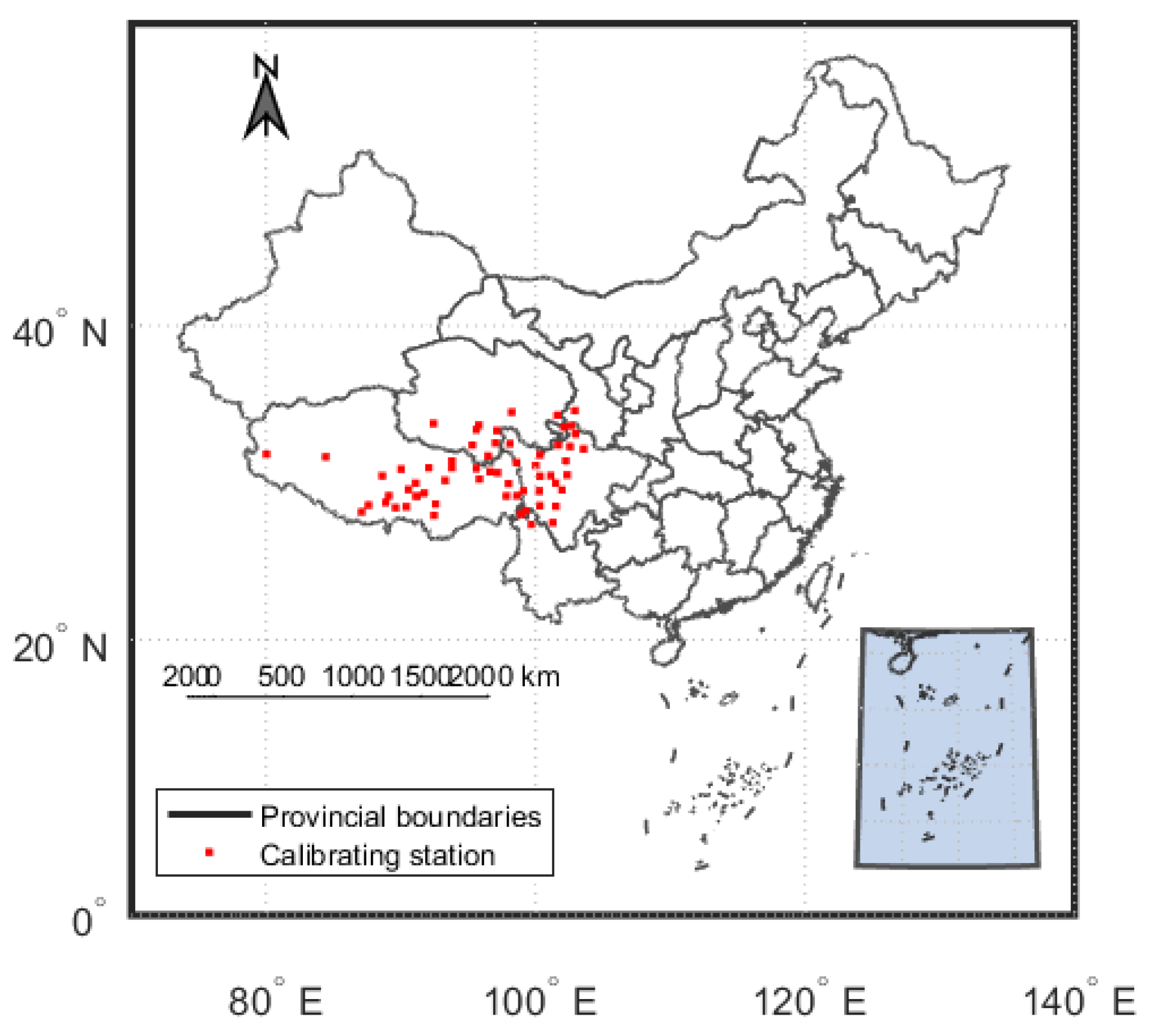
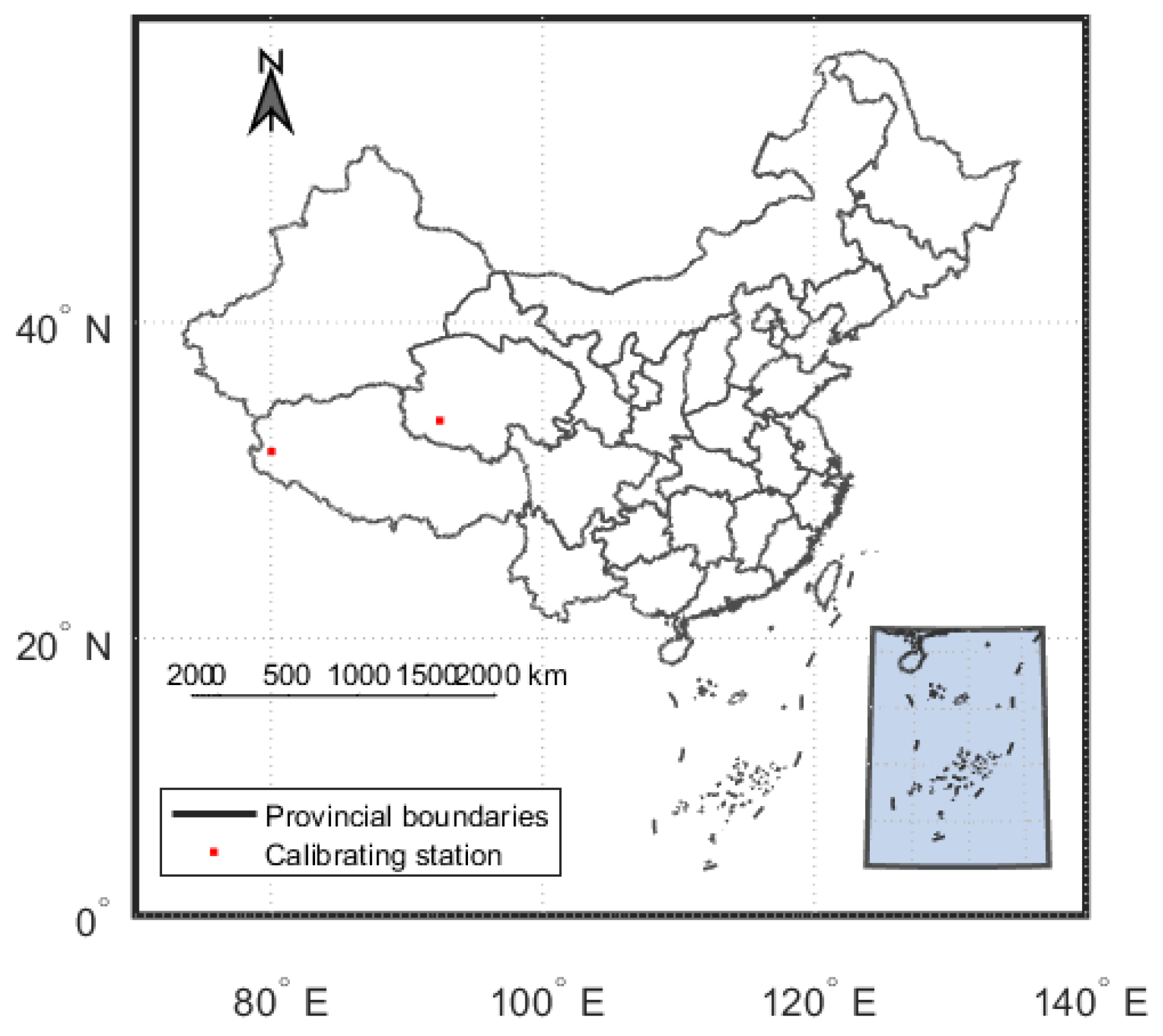
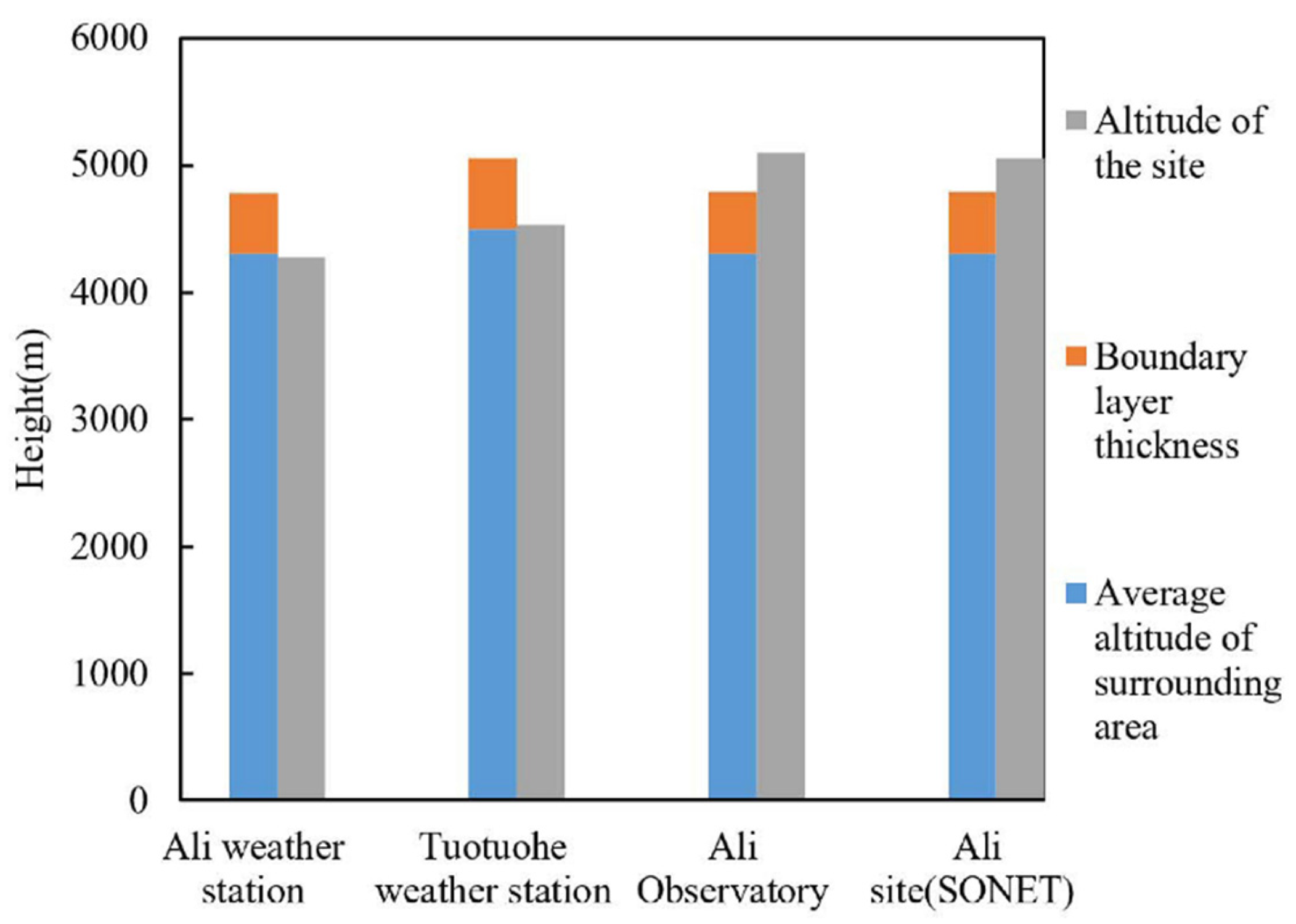
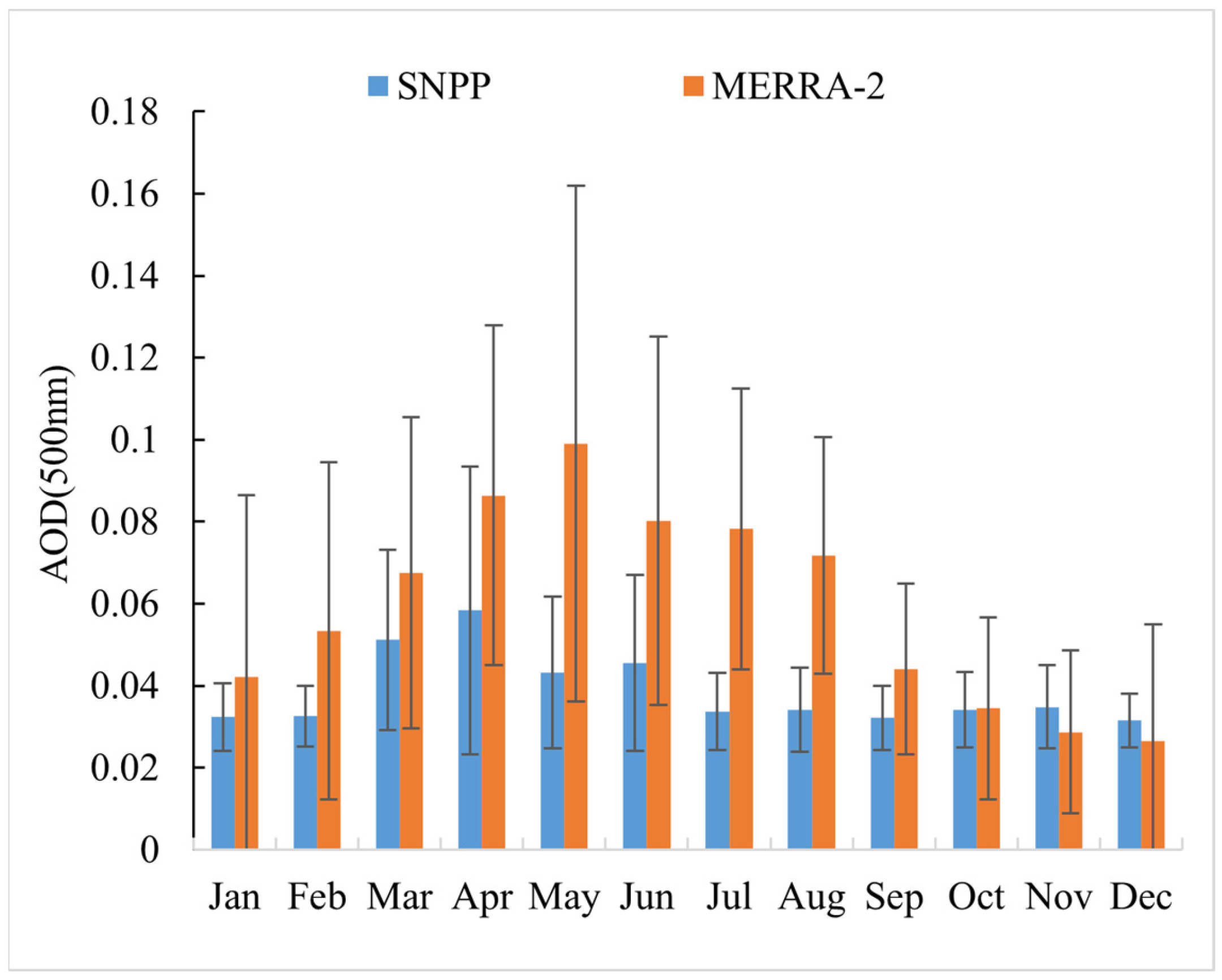
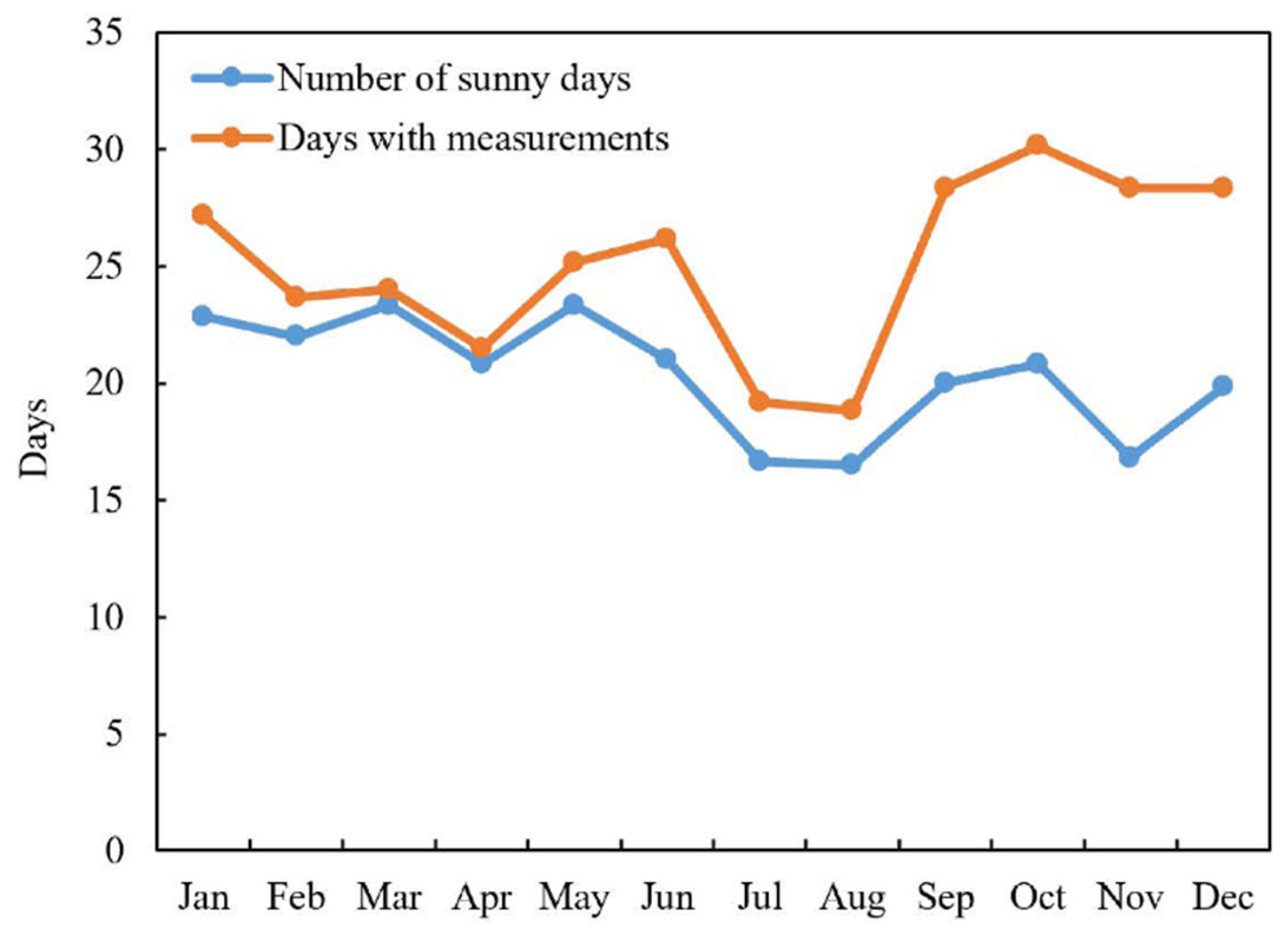
| Data Sources | Data Name | Time Resolution | Horizontal Resolution Grid | Time Interval of Data |
|---|---|---|---|---|
| SNPP/VIIRS | AERDB_M3_VIIRS_SNPP | Monthly | 1° × 1° | 2013–2020 |
| CERES | CERES_SSF1deg_Ed4.1 (Terra-MODIS) | Monthly | 1° × 1° | 2011–2020 |
| MERRA-2 | instM_2d_gas_Nx | Monthly | 0.625° × 0.5° | 2011–2020 |
| Station | Address | Latitude (°N) | Longitude (°E) | Altitude (m) | Mean Number of Clear-Sky Days per Month |
|---|---|---|---|---|---|
| Ali weather station | Shiquanhe, Ali, Tibet | 32.5 | 80.08 | 4278.6 | 14.47 |
| Tuotuohe weather station | Tanggulashan, Golmud, Qinghai | 34.22 | 92.43 | 4533.1 | 16.76 |
| Ali observatory | Shiquanhe, Ali, Tibet | 32.33 | 80.03 | 5100 | 20.33 |
| SONET’s Ali station | Shiquanhe, Ali, Tibet | 32.33 | 80.03 | 5053 | 20.21 |
| Station | Latitude | Monthly Mean AOD a | Monthly Mean Standard Deviation of AOD | Monthly Mean Number of Clear-Sky Days b | Position in the Atmosphere |
|---|---|---|---|---|---|
| Ali observatory | 32.33° N | 0.059 | 0.013 | 20.33 | Free troposphere |
| Mauna Loa observatory | 19.88° N | 0.096 | 0.044 | 24.17 | Free troposphere |
| Izaña observatory | 28.31° N | 0.142 | 0.099 | 19.58 | Free troposphere |
Disclaimer/Publisher’s Note: The statements, opinions and data contained in all publications are solely those of the individual author(s) and contributor(s) and not of MDPI and/or the editor(s). MDPI and/or the editor(s) disclaim responsibility for any injury to people or property resulting from any ideas, methods, instructions or products referred to in the content. |
© 2023 by the authors. Licensee MDPI, Basel, Switzerland. This article is an open access article distributed under the terms and conditions of the Creative Commons Attribution (CC BY) license (https://creativecommons.org/licenses/by/4.0/).
Share and Cite
Xun, L.; Liu, X.; Lu, H.; Zhang, J.; Yan, Q. Screening Approach of the Langley Calibration Station for Sun Photometers in China. Atmosphere 2023, 14, 1641. https://doi.org/10.3390/atmos14111641
Xun L, Liu X, Lu H, Zhang J, Yan Q. Screening Approach of the Langley Calibration Station for Sun Photometers in China. Atmosphere. 2023; 14(11):1641. https://doi.org/10.3390/atmos14111641
Chicago/Turabian StyleXun, Lina, Xue Liu, Hui Lu, Jingjing Zhang, and Qing Yan. 2023. "Screening Approach of the Langley Calibration Station for Sun Photometers in China" Atmosphere 14, no. 11: 1641. https://doi.org/10.3390/atmos14111641





